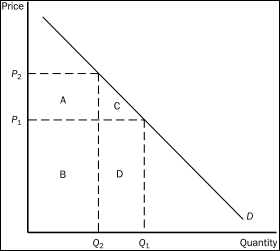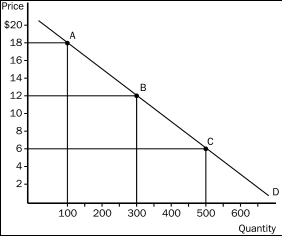A) substitutes, and have a cross-price elasticity of 0.60.
B) complements, and have a cross-price elasticity of 0.60.
C) substitutes, and have a cross-price elasticity of 1.67.
D) complements, and have a cross-price elasticity of 1.67.
Correct Answer

verified
Correct Answer
verified
True/False
A linear,downward-sloping demand curve has constant elasticity,but not constant slope.
Correct Answer

verified
Correct Answer
verified
Multiple Choice
For which of the following goods is the income elasticity of demand likely highest?
A) water
B) diamonds
C) hamburgers
D) housing
Correct Answer

verified
Correct Answer
verified
Multiple Choice
Figure 5-7
 -Refer to Figure 5-7.If rectangle D is larger than rectangle A,then
-Refer to Figure 5-7.If rectangle D is larger than rectangle A,then
A) demand is elastic between prices P₁ and P₂.
B) a decrease in price from P₂ to P₁ will cause an increase in total revenue.
C) the magnitude of the percent change in price between P₁ and P₂ is smaller than the magnitude of the corresponding percent change in quantity demanded.
D) All of the above are correct.
Correct Answer

verified
Correct Answer
verified
Multiple Choice
Figure 5-2
 -Refer to Figure 5-2.Sellers' total revenue would increase if the price
-Refer to Figure 5-2.Sellers' total revenue would increase if the price
A) increased from $6 to $8.
B) decreased from $18 to $16.
C) decreased from $16 to $15.
D) All of the above are correct.
Correct Answer

verified
Correct Answer
verified
Multiple Choice
Frequently,in the short run,the quantity supplied of a good is
A) impossible, or nearly impossible, to measure.
B) not very responsive to price changes.
C) determined by the quantity demanded of the good.
D) determined by psychological forces and other non-economic forces.
Correct Answer

verified
Correct Answer
verified
Multiple Choice
Which of the following statements does not help to explain why government drug interdiction increases drug-related crime?
A) The demand for illegal drugs is inelastic.
B) Interdiction results in drug addicts having a greater need for quick cash.
C) Interdiction results in an increase in the amount of money needed to buy the same amount of drugs.
D) Government drug programs are more lenient now with drug offenders than they were in the 1980s.
Correct Answer

verified
Correct Answer
verified
Multiple Choice
Figure 5-2
 -Refer to Figure 5-2.Which of the following price changes would result in no change in sellers' total revenue?
-Refer to Figure 5-2.Which of the following price changes would result in no change in sellers' total revenue?
A) The price increases from $6 to $9.
B) The price increases from $9 to $15.
C) The price decreases from $12 to $9.
D) The price decreases from $9 to $5.
Correct Answer

verified
Correct Answer
verified
Multiple Choice
Between 1950 and 2000 there was a
A) 20 percent drop in the number of farmers, but farm output more than tripled.
B) 30 percent drop in the number of farmers, but farm output more than tripled.
C) 50 percent drop in the number of farmers, but farm output more than doubled.
D) 70 percent drop in the number of farmers, but farm output more than doubled.
Correct Answer

verified
Correct Answer
verified
Multiple Choice
You and your college roommate eat three packages of Ramen noodles each week.After graduation last month,both of you were hired at several times your college income.You still enjoy Ramen noodles very much and buy even more,but your roommate plans to buy fewer Ramen noodles in favor of foods she prefers more.When looking at income elasticity of demand for Ramen noodles,
A) yours would be negative and your roommate's would be positive.
B) yours would be positive and your roommate's would be negative.
C) yours would be zero and your roommate's would approach infinity.
D) yours would approach infinity and your roommate's would be zero.
Correct Answer

verified
Correct Answer
verified
Multiple Choice
A key determinant of the price elasticity of supply is the time period under consideration.Which of the following statements best explains this fact?
A) Supply curves are steeper over long periods of time than over short periods of time.
B) Buyers of goods tend to be more responsive to price changes over long periods of time than over short periods of time.
C) The number of firms in a market tends to be more variable over short periods of time than over long periods of time.
D) Firms tend to be more responsive to price changes over long periods of time than over short periods of time.
Correct Answer

verified
Correct Answer
verified
Multiple Choice
Suppose that when the price of corn is $2 per bushel,farmers can sell 10 million bushels.When the price of corn is $3 per bushel,farmers can sell 8 million bushels.Which of the following statements is true?
A) The demand for corn is income inelastic, and so an increase in the price of corn will increase the total revenue of corn farmers.
B) The demand for corn is income elastic, and so an increase in the price of corn will increase the total revenue of corn farmers.
C) The demand for corn is price inelastic, and so an increase in the price of corn will increase the total revenue of corn farmers.
D) The demand for corn is price elastic, and so an increase in the price of corn will increase the total revenue of corn farmers.
Correct Answer

verified
Correct Answer
verified
Multiple Choice
Elasticity improves our understanding of supply and demand by adding
A) measures of equity.
B) measures of efficiency.
C) a quantitative element to our analysis.
D) a qualitative element to our analysis.
Correct Answer

verified
Correct Answer
verified
Multiple Choice
Muriel's income elasticity of demand for football tickets is 1.50.All else equal,this means that if her income increases by 20 percent,she will buy
A) 150 percent more football tickets.
B) 50 percent more football tickets.
C) 30 percent more football tickets.
D) 20 percent more football tickets.
Correct Answer

verified
Correct Answer
verified
Multiple Choice
Generally,a firm is more willing and able to increase quantity supplied in response to a price change when
A) the relevant time period is short rather than long.
B) the relevant time period is long rather than short.
C) supply is inelastic.
D) the firm is experiencing capacity problems.
Correct Answer

verified
Correct Answer
verified
Multiple Choice
You are in charge of the local city-owned golf course.You need to increase the revenue generated by the golf course in order to meet expenses.The mayor advises you to increase the price of a round of golf.The city manager recommends reducing the price of a round of golf.You realize that
A) the mayor thinks demand is elastic and the city manager thinks demand is inelastic.
B) both the mayor and the city manager think that demand is elastic.
C) both the mayor and the city manager think that demand is inelastic.
D) the mayor thinks demand is inelastic and the city manager thinks demand is elastic.
Correct Answer

verified
Correct Answer
verified
True/False
OPEC failed to maintain a high price of oil in the long run,partly because both the supply of oil and the demand for oil are more elastic in the long run than in the short run.
Correct Answer

verified
Correct Answer
verified
Multiple Choice
If an increase in income results in a decrease in the quantity demanded of a good,then for that good,
A) the cross-price elasticity of demand is negative.
B) the price elasticity of demand is negative.
C) the income elasticity of demand is negative.
D) an increase in the market supply will increase the equilibrium price of the good.
Correct Answer

verified
Correct Answer
verified
Multiple Choice
A good will have a more inelastic demand,
A) the greater the availability of close substitutes.
B) the broader the definition of the market.
C) the longer the period of time.
D) the more it is regarded as a luxury.
Correct Answer

verified
Correct Answer
verified
Multiple Choice
Which of the following statements is not correct concerning government attempts to reduce the flow of illegal drugs into the country?
A) Drug interdiction raises prices and total revenue in the drug market.
B) Drug interdiction can increase drug-related crime.
C) Drug interdiction shifts the demand curve for drugs to the left.
D) Drug interdiction shifts the supply curve of drugs to the left.
Correct Answer

verified
Correct Answer
verified
Showing 181 - 200 of 282
Related Exams